NHS facing ‘storm of pressure’ as flu cases surge in winter virus outbreak
Top doctor warns junior doctors’ strike next week will be more ‘severe’ for NHS than the last round

Your support helps us to tell the story
From reproductive rights to climate change to Big Tech, The Independent is on the ground when the story is developing. Whether it's investigating the financials of Elon Musk's pro-Trump PAC or producing our latest documentary, 'The A Word', which shines a light on the American women fighting for reproductive rights, we know how important it is to parse out the facts from the messaging.
At such a critical moment in US history, we need reporters on the ground. Your donation allows us to keep sending journalists to speak to both sides of the story.
The Independent is trusted by Americans across the entire political spectrum. And unlike many other quality news outlets, we choose not to lock Americans out of our reporting and analysis with paywalls. We believe quality journalism should be available to everyone, paid for by those who can afford it.
Your support makes all the difference.The NHS is facing a “storm” of pressure as the number of flu patients in hospital surges before the longest junior doctors’ strike on record.
As the health service battled industrial action ahead of Christmas day, a total of 942 people were in hospital every day last week with flu – more than double the 402 recorded a fortnight earlier and up from 579 the week before.
Of these, there were 48 people in critical care beds, NHS England data shows. The total is six times higher compared to November, when just 160 beds each day were filled with flu patients, and represents the highest figure so far this winter.
Cases of Covid in hospitals are also creeping up, with an average of 3,631 patients in hospital each day last week compared to 3,248 the week before – up from 2,294.
The NHS’ most senior doctor Stephen Powis said: “These figures demonstrate the storm of pressure the NHS is facing, with huge rises in flu patients over the last few weeks and many more norovirus cases than we saw last winter, as well as the ongoing impact of Covid – all on top of the added pressure of industrial action.”
The figures come amid another spell of industrial action by junior doctors in England, with the 72-hour strike from 20 to 23 December due to be followed by a six-day strike in early January when thousands more appointments and operations are expected to be cancelled. The walkouts are part of a long-running dispute over pay.
On Wednesday, NHS England said 86,329 patient appointments and operations were rescheduled due to the junior doctors’ strikes.

Healthcare leaders have said they fear for patients’ safety during the next round of strikes, as it is held during what is traditionally the most pressured week for the NHS.
Sir Stephen warned the impact of next week’s six-day strike is “likely to be much more severe”, coming at a time when hospitals “usually experience the most pressure with high demand and higher levels of virus admissions”.
The data shows the winter viruses are affecting staffing levels, with an average of 2,597 employees off with Covid alone each day last week, up 51 per cent from November.
The Independent revealed warnings from top doctors last week over dwindling flu vaccination uptake among frontline NHS staff.
Although admissions to hospitals were up, ambulance pressures appear have improved on last year with 14,262 hours lost to ambulances being delayed outside of hospitals last week compared to 35,292 in the same week last year.
Sir Julian Hartley, chief executive of NHS Providers, which represents NHS trusts in England, described the drop in handover delays as “encouraging”.
But he said the “worrying” winter virus figures demonstrated the “scale of the challenge” facing the NHS. “We urge the government and unions to think afresh and find a way to resolve the damaging and demoralising industrial dispute which has caused so much disruption for patients. There is still time to head off the longest strike in the history of the NHS.”
Norovirus levels, while high compared with last year, have also fallen in the latest figures, with an average of 451 adult hospital beds filled last week by patients with diarrhoea and vomiting or norovirus-like symptoms.
This is down 20 per cent from 566 beds the previous week but still nearly two-thirds (62 per cent) higher than at this stage last year, when the average stood at 279.
Join our commenting forum
Join thought-provoking conversations, follow other Independent readers and see their replies
Comments